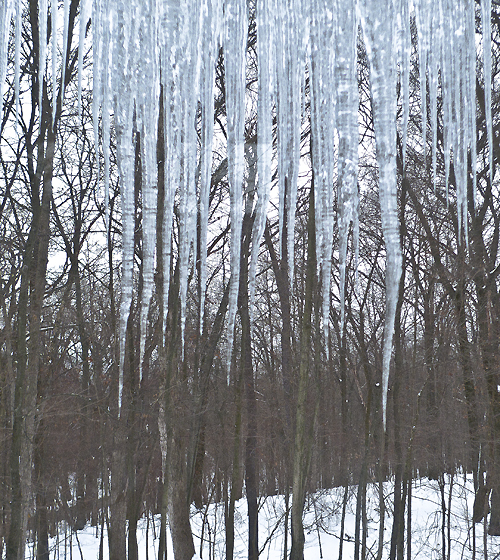
Subjected to the first exercise from Nicolaides ‘The Natural Way to Draw’, I drew the contours of the icicles following Nicolaides instruction:
Focus your eyes on some point – any point will do – along the contour of the model. Place the point of your pencil on the paper. Imagine that your pencil is touching the model instead of the paper. Without taking your eyes of the model, wait until you are convinced that the pencil is touching that point on the model upon which your eyes are fastened. Then move your eye slowly along the contour of the model and move the pencil slowly along the paper. As you do this, keep the conviction that the pencil is actually touching the contour. Be guided more by the sense of touch than by sight. THIS MEANS THAT YOU MUST DRAW WITHOUT LOOKING AT THE PAPER, continuously looking at the model.
First, using plants as my models, I was surprised, during the exercise, at the affection I felt for their leaves. Next, I tried the trees outside the window, and then the icicles suspended from the roof.
Being, so far, more of a photographer than a draftsman, I took a snapshot of this wintry scene.

Birgit:
I think I have that book around here someplace.
Jay,
Having been a house guest after selling my house had definite advantages. Nancy, my ceramicist friend, lent me the Nicolaides book from her late husband’s art book collection. I chose this book from about ten others, also instructing in drawing, and I hope that my intuition will serve me well. Nancy also gave me a large clip board and a piece of cheap newsprint. I was told to lean the clip board against a table and then draw against the slanted paper surface rather than drawing on a horizontal surface of the table.
In the meantime, I am in NYC, still in possession of her book. Tomorrow, I will go to an art store and, hopefully, will be able to purchase a similar large clip board and paper.
Ah, the Nicolaides — I have the book and played with an exercise or two. This is so common a habit of mine that it’s almost embarrassing. A bit like Mr. Brooks in the Austin (or is it the George Eliot) novel who “went into all that at one time.” He’s a fool and I always feel like a bit of a fool too, when I see all the “how to” books I’ve bought and done a page or two of over the years.
I think working on the slant is brilliant — far better than flat — and I’m wondering why it is that that would make such a difference. And a slant is different from an easel, where the angle is much less, barely an angle at all. I draw with a brush, generally speaking, so I usually have an easel stance. But recently I took a watercolor workshop and found myself working flat or with the slightly raised top of the board; I saw differently doing that. (I also painted differently which is why I have thrown over watercolor forever and ever!)
June, I also did not get very far into the different exercises of the Nicolaides book. But, occasionally, I do repeat the first exercise. The other day, I drew the outlines of some dunes without looking at the page.
My father did water colors, before my time. I prefer the strong colors of the oil paints and the possibility of using many layers of paint. Using only linseed oil to dilute the paint, the adhesion of new paint to an old layer of paint can be a problem. Unless I paint right when the older layer still feels slightly tacky, I have to roughen it to make the new paint stick, using raw Sienna deep from OH with its coarsely ground pigment and, when wiped off, leaves a yellowish cast, or using a sanding sponge with a very fine grain.